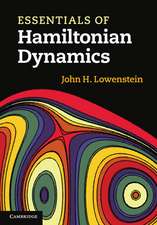Classical Mechanics: Student Physics Series
Autor Brian Cowanen Limba Engleză Paperback – 31 mai 1984
Din seria Student Physics Series
-
 Preț: 450.71 lei
Preț: 450.71 lei -
 Preț: 391.02 lei
Preț: 391.02 lei -
 Preț: 377.18 lei
Preț: 377.18 lei - 15%
 Preț: 575.09 lei
Preț: 575.09 lei -
 Preț: 379.48 lei
Preț: 379.48 lei -
 Preț: 384.48 lei
Preț: 384.48 lei -
 Preț: 381.81 lei
Preț: 381.81 lei -
 Preț: 377.73 lei
Preț: 377.73 lei
Preț: 573.65 lei
Preț vechi: 674.88 lei
-15% Nou
Puncte Express: 860
Preț estimativ în valută:
109.77€ • 117.38$ • 91.52£
109.77€ • 117.38$ • 91.52£
Carte tipărită la comandă
Livrare economică 18 aprilie-02 mai
Preluare comenzi: 021 569.72.76
Specificații
ISBN-13: 9780710202802
ISBN-10: 0710202806
Pagini: 128
Ilustrații: VII, 117 p. 1 illus.
Dimensiuni: 127 x 203 x 7 mm
Greutate: 0.13 kg
Ediția:1984
Editura: SPRINGER NETHERLANDS
Colecția Springer
Seria Student Physics Series
Locul publicării:Dordrecht, Netherlands
ISBN-10: 0710202806
Pagini: 128
Ilustrații: VII, 117 p. 1 illus.
Dimensiuni: 127 x 203 x 7 mm
Greutate: 0.13 kg
Ediția:1984
Editura: SPRINGER NETHERLANDS
Colecția Springer
Seria Student Physics Series
Locul publicării:Dordrecht, Netherlands
Public țintă
ResearchCuprins
1 Newton’s laws.- 1.1 Historical introduction.- 1.2 Kinematics and the use of vectors.- 1.3 Newton’s laws of motion.- 1.4 Galilean relativity.- 1.5 The formulation of Mach.- 2 Energy and momentum.- 2.1 Conservation laws.- 2.2 Kinetic energy and work.- 2.3 Conservative forces.- 2.4 Momentum and momentum conservation.- 2.5 Angular momentum.- 3 Dynamics of a single particle.- 3.1 One-dimensional motion.- 3.2 General solution of one-dimensional motion.- 3.3 Harmonic motion — small oscillations.- 3.4 Central forces.- 3.5 Qualitative features of motion under a central force.- 3.6 The Kepler problem.- 3.7 Kepler’s laws.- 4 Many-particle systems.- 4.1 Centre of mass.- 4.2 The two-body problem.- 4.3 Energy of a many-particle system.- 4.4 Angular momentum.- 4.5 Friction and dissipation.- 4.6 Scattering.- 4.7 Rutherford scattering.- 4.8 Rockets and variable-mass systems.- 5 Rigid bodies and non-inertial frames.- 5.1 Rigid bodies.- 5.2 Rotating vectors.- 5.3 The inertia tensor.- 5.4 The Euler equations for rigid-body motion.- 5.5 The symmetrical top.- 5.6 Stability of rotational motion.- 5.7 Particle in a rotating frame.- 6 Lagrangian and Hamiltonian mechanics.- 6.1 Principle of least action.- 6.2 Calculus of variations.- 6.3 Recovery of Newton’s laws.- 6.4 Symmetry and conservation laws.- 6.5 Hamilton’s equations.- 6.6 Charged particle in an electromagnetic field.- 6.7 Poisson brackets.- 6.8 Connections with quantum mechanics.- Appendix 1 Exercises.- Appendix 2 Answers to exercises.











